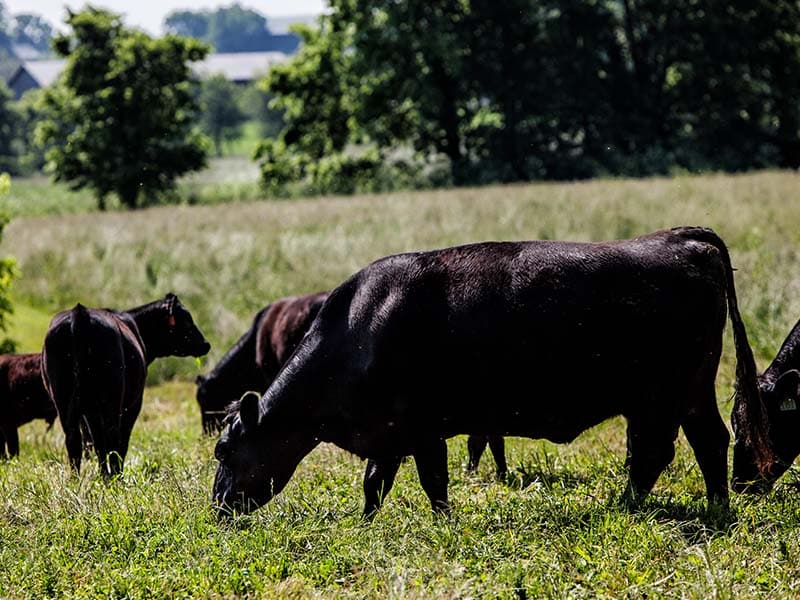
With many of us spending more time in the kitchen than ever before, there are also more questions about how this food came to be. Has this spinach been in a box or warehouse somewhere for a week, or was it harvested fresh on a farm nearby? Similarly—and the point of this article—is this burger from a factory-farmed animal or one that was bluegrass-fed just out of town or not from an animal at all?
The justification for this posting is the rapid rise in the adoption of plant-based “beef” that is gaining market share across the country. While I am not concerned about the competition to our beef business, I am concerned about how easily this “food” has been accepted by the general public. Scientists—not farmers—are frantically working to turn genetically modified soybeans into “chicken” and “pork.” They declare domesticated animals will no longer be necessary on the planet, given they are so messy. I still say, science is on our side.
So these highly improbable burgers, not to call anyone out by name, are soybeans that have gone through all types of machines for cooking, mixing, component separation and remixing with all sorts of manmade ingredients with unpronounceable names. I picture lots of stainless-steel tanker trucks backed up to a row of dock doors in a building with no windows and a chain link fence around it. I guess the US Department of Agriculture and the Food and Drug Administration have checked it out as technically fit for human consumption, but is it OK? Just because you can do something doesn’t mean you should.
In my mind, beef (actual beef, with no quotations) is the muscle of Bos taurus. In our case, this is derived from an umpteenth generation of bovine born on Elmwood Stock Farm. It was rotationally grazed around the farm with its herd for a couple of years. No adulterations are imposed upon them. Grass, water, salt: That’s it. This is beef as nature intended for the last tens of thousands of years.
One advent of technology we do use for managing our beef herd is artificial insemination of the cows. Semen is collected from bulls, selected for their conformation and growth ability. The catalog of traits we can select from is extensive. Generally speaking, we want to breed smaller-framed animals, as they tend to bloom on a grass-fed, grass-finished diet, whereas larger-framed beasts require grain to finish with the same level of marbling (intramuscular fat). John has been incorporating Wagyu breed bulls into the mix, a Japanese breed known for tenderness, flavor and marbling of the meat. While the bull’s contribution to our herd arrives in a little plastic straw, it is half of the genetics of the herd, which slowly changes over the decades.
With years of beef-quality grading information from our abattoir, John has been able to refine Elmwood Stock Farm’s herd genetics and grazing techniques. More than 80 percent of our beef grades USDA Choice—high marks for a quality eating experience. Those few that grade Select make excellent sausages and ground beef and are not sold as steaks or roasts. Last year, two of our beef cattle graded Prime, which is the highest beef grade and almost unheard of for grass-fed, grass-finished beef.
Be mindful that any grass-fed beef you source has enough marbling to cook well. Very lean grass-fed beef, which would likely grade Select, must be handled differently in the kitchen to avoid a tough, dry end product.
Plant-based “meat” proponents argue that real beef animals are bad for the environment, when actually beef raised our way sequesters carbon in the soil. The animals remove nutrients from the fields in the form of grass and hay and return nutrients to the fields in the form of manure to help grow more grass. The consistent rotation of the herds though the fields keeps animals and farm ecosystems healthy. (Read about the difference between our grass-fed, grass-finished beef and mainstream conventionally produced beef.)
While the plant-based “meats” tout their positive impact on the environment, I’m not sure promoting the use of all the synthetic pesticides and fertilizers to grow all those genetically modified soybeans is so great for the land or environment where they are grown. The factories and “plants” where all the other Frankenfood ingredients are fabricated must have their issues with waste and potential pollutants, too. We could look at the impact of trucking these things around the country, if nothing else.
Plant-based burgers may provide some basic building blocks of human nutrition, but considering them “meat” is more than a stretch. Just like the dozen or more multinational fast-food chain restaurants I have never been to, soybeans made to taste like a hamburger will never cross these lips.
Likewise, knowingly eating mainstream meats is hard for me to swallow. We avoid them when eating out (or when we used to eat out), which leads me back to grass-fed beef. Just like spinach, if you don’t think you like the taste or texture of grass-fed beef, I urge you to try Elmwood Stock Farm’s grass-fed and grass-finished, USDA Choice, dry-aged, locally grown, certified-organic, Angus-Wagyu beef.
Not sure where to start? Contact us, and we’ll set you up with the right organic, grass-fed beef cuts and some cooking encouragement. —Mac Stone


Made with 
